Choosing the right email marketing platform is crucial for business owners looking to grow their customer base and drive sales. GetResponse and TinyEmail are two popular options, each with their own strengths.
GetResponse is an industry leader that’s been around since the late 1990s, while TinyEmail is a relative newcomer that offers affordable pricing.
In this comprehensive GetResponse vs TinyEmail comparison, we’ll look at key factors like market position, ease of use, customization options, features, website performance, customer support, pricing, reviews, and reputation. By evaluating these platforms across these categories, you’ll get a clear picture of which solution may be the best fit for your business goals and budget.
1. Understanding the Basics
GetResponse was founded in 1997 by Simon Grabowski, who still serves as CEO today. It’s one of the oldest and most established email marketing platforms, currently used by over 350,000 businesses worldwide. GetResponse has a strong market presence, especially among small to medium-sized companies.
TinyEmail entered the market in 2020, founded by Seamas Egan. As a newer platform, TinyEmail has a smaller but fast-growing user base of around 8,000 customers. Its competitive pricing makes it attractive for solopreneurs and early-stage startups on a budget.
Both platforms have active Facebook user communities:
Joining these groups allows you to connect with other users, ask questions, and get insights on using each platform. With over 25 years in business, GetResponse clearly has the advantage when it comes to popularity and reputation. But TinyEmail is gaining ground as a budget-friendly newcomer in the market.
2. Features and Functionality
With so many options on the market, it can feel overwhelming to decide which platform to trust. Our criteria for comparison aims to cut through the noise by focusing on the core features that matter most:
Will it help you create professional email marketing campaigns? Does it offer advanced automation options? Will it integrate with your other software? Does it provide the level of support you need? Follow along as we break down how GetResponse and TinyEmail stack up to help you make a confident decision.
Automation
GetResponse
GetResponse offers a wide range of marketing automation tools to help streamline your email marketing workflows. You can create sequences that send targeted messages to subscribers when they take specific actions.
For example, you can set up a welcome sequence to onboard new subscribers by sending a series of emails over a few days or weeks. Each message can educate subscribers about your brand, products, or services. You can also create sequences for abandoned carts, product launches, events, and more.
With GetResponse’s automation builder, you can set up triggers based on subscriber behaviors like email opens, link clicks, date-based events, and custom field values. You can configure delays between messages, branch into different paths, and build segmented lists to send messages to specific groups.
Advanced automation capabilities involve setting up multi-step funnels with conditional logic. GetResponse makes it easy to visualize workflows with a drag-and-drop builder. You can also use webhooks to connect your email automation with other apps and services.
Overall, GetResponse sets the standard for intuitive and versatile automation capabilities. Their pre-built templates and granular targeting options allow you to execute targeted sequences that convert.
TinyEmail

TinyEmail provides basic automation features for small businesses to create workflows without advanced coding skills. You can set up welcome emails for new subscribers, create sequences based on dates or email actions, and customize automated messages for each stage.
The visual editor makes it easy to build your workflows step-by-step. You can configure delays, branch into up to 5 alternative paths, and set up restart sequences if subscribers go dormant.
While TinyEmail lacks some of the robust options offered by GetResponse, the automation builder covers the essentials for basic email sequences. It’s easy to set up lifecycle campaigns to nurture subscribers from signup to first purchase. However, complex multi-step funnels with custom logic may require more advanced tools.
TinyEmail focuses on core automation features that early-stage businesses need. The simple editor and pre-built templates make it quick to create sequences without technical expertise. However, larger or more established brands may need expanded options over time.
Winner: GetResponse
GetResponse deserves the win for the best email automation tools. Their workflow builder offers greater flexibility through advanced conditional logic, custom field segmentation, and seamless integrations.
Marketers can create highly tailored sequences mapped to each subscriber’s journey. While TinyEmail provides useful basic options, GetResponse delivers enterprise-level automation for sophisticated email strategies.
Email Templates
GetResponse

GetResponse offers hundreds of professionally designed email templates covering a wide range of categories to help you create visually appealing emails. You’ll find templates for welcome sequences, product launches, newsletters, holidays, and more.
The template library makes it easy to search based on industry, campaign type, and layout. You can preview responsive designs optimized for mobile. Templates are fully customizable – change colors, fonts, and images to match your brand.
GetResponse also lets you create your own custom HTML templates from scratch or by editing existing templates. The drag-and-drop editor simplifies building new templates without coding knowledge.
Overall, GetResponse provides beautiful pre-made templates along with powerful customization tools. You can find on-brand templates for all your needs or build your own tailored designs.
TinyEmail
TinyEmail has a small collection of basic email templates to choose from. They offer general templates for welcome emails, sales announcements, newsletters, and holidays.
The templates provide a clean, simple layout that you can customize with your own color scheme, logos, and images. There are only a handful of templates for each category, so you’ll likely need to make adjustments to find the right fit.
Currently, TinyEmail does not allow the creation of custom HTML email templates from scratch. Their template editor has limited options compared to GetResponse. You cannot heavily modify the existing templates beyond basic formatting changes.
TinyEmail’s templates work well for simple text-based emails. But if you need more complex, on-brand template designs, GetResponse is a better choice. TinyEmail’s template functionality lags behind in customization abilities.
Winner: GetResponse
GetResponse is the clear winner for its vast library of professionally designed email templates. The wide variety of responsive, visually appealing templates streamlines your email creation process. Extensive customization options allow you to tailor templates to match your brand identity. While TinyEmail provides decent basic templates, GetResponse offers far superior template design capabilities.
Segmentation
GetResponse
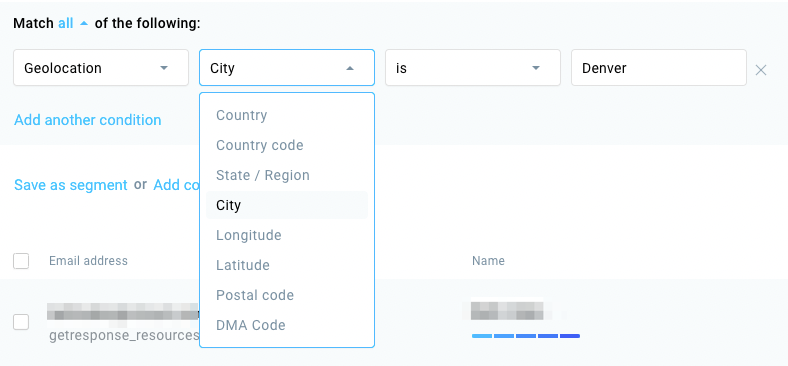
GetResponse provides extensive options for segmenting your subscriber lists to target emails. You can create segments based on subscriber data including demographics, contact info, activity history, and customer journey.
Built-in filters let you quickly segment by data points like email opens, clicks, location, purchase history, and more. You can also create custom segments using advanced logic and conditions. For example, target subscribers from a certain city who have opened but not clicked recent campaign emails.
In addition, tags allow you to manually categorize contacts for segmentation. Assign tags based on interests, demographics, or behaviors, then target subgroups accordingly.
With GetResponse’s segmentation tools, you can divide large lists into smaller, highly targeted segments. Send the right message to the right subscribers based on their attributes and actions.
TinyEmail
TinyEmail has basic segmentation capabilities based on groups, tags, and subscriber activity. You can manually create groups to send specific emails to subsets of your list. Tags also help you categorize contacts for targeting.
For activity-based segmentation, you can filter contacts by all-time opens/clicks or by interaction with particular campaigns. This allows targeting engaged subscribers from previous sends.
However, TinyEmail currently lacks more advanced subscriber data segmentation. There is no option to create segments based on detailed subscriber profiles and journey history. The platform’s targeting capabilities only scratch the surface of what GetResponse can provide.
Overall, TinyEmail covers the fundamentals but doesn’t offer robust, nuanced segmentation like GetResponse. Marketers may find themselves limited when trying to divide lists into hyper-targeted groups.
Winner: GetResponse
GetResponse takes the prize for its powerful subscriber segmentation tools. Granular targeting options based on detailed subscriber data allow you to personalize messaging with precision. TinyEmail only provides basic segmentation, lacking the sophistication of GetResponse’s filters, custom field logic, and combo segmentation. For marketers who rely heavily on list segmentation for campaigns, GetResponse is the superior choice.
Analytics
GetResponse
GetResponse provides powerful analytics to track and optimize your email marketing performance. Their dashboards offer comprehensive campaign statistics including open/click rates, conversions, unsubscribes, social shares, and more.
You can dive deeper into individual sends to view real-time metrics on deliverability, engagement, and ROI. Interactive reports allow you to segment data by timeline, geography, or subscriber attributes to spot trends.
GetResponse also integrates with Google Analytics for expanded insights. Track subscriber engagement across devices, including email-to-website conversions. Their analytics provide deep visibility into your subscriber journeys.
With GetResponse’s robust analytics, you can closely monitor metrics to continually improve campaign performance. Detailed segmentation empowers informed optimizations tailored to your audience.
TinyEmail
TinyEmail delivers basic email analytics through campaign reports and list statistics. You can view top-level data on opens, clicks, unsubscribes, and spam reports.
Drill into individual campaigns to see deliverability rates, most popular links, and engagement graphs over time. TinyEmail provides the key metrics needed to grasp campaign effectiveness.
However, custom segmentation options are limited for deeper analysis. The platform lacks advanced behavioral workflows to track subscriber journeys from email to site. Integrations with Google Analytics are not supported either.
While TinyEmail covers essential analytics needs, GetResponse provides more powerful functionalities for maximizing insights. Marketers may find themselves wanting more segmented, actionable data to optimize email strategies over time.
Winner: GetResponse
GetResponse wins for its enterprise-grade email analytics capabilities. Robust segmentation and integration tools provide a deeper understanding of subscriber behaviors. TinyEmail offers a sufficient high-level view but lacks the fine-tuned tracking and customization GetResponse delivers. For marketers who rely heavily on analytics, GetResponse provides superior email insights to optimize engagement.
Unique Features
GetResponse
GetResponse stands out for its webinar marketing capabilities. The platform is integrated with WebinarJam to help users generate leads through live or automated webinars.
You can host webinars directly within GetResponse and leverage email marketing to promote and follow up with registrants. Useful features include registration forms, recurring webinars, polls, Q&As, and detailed webinar analytics.
This combination of email marketing and webinars in one platform makes GetResponse a uniquely powerful solution. Webinars expand your lead gen and engagement opportunities beyond basic email.
Other noteworthy GetResponse features include web push notifications, advanced email authentication features, and advanced segmentation options.
TinyEmail
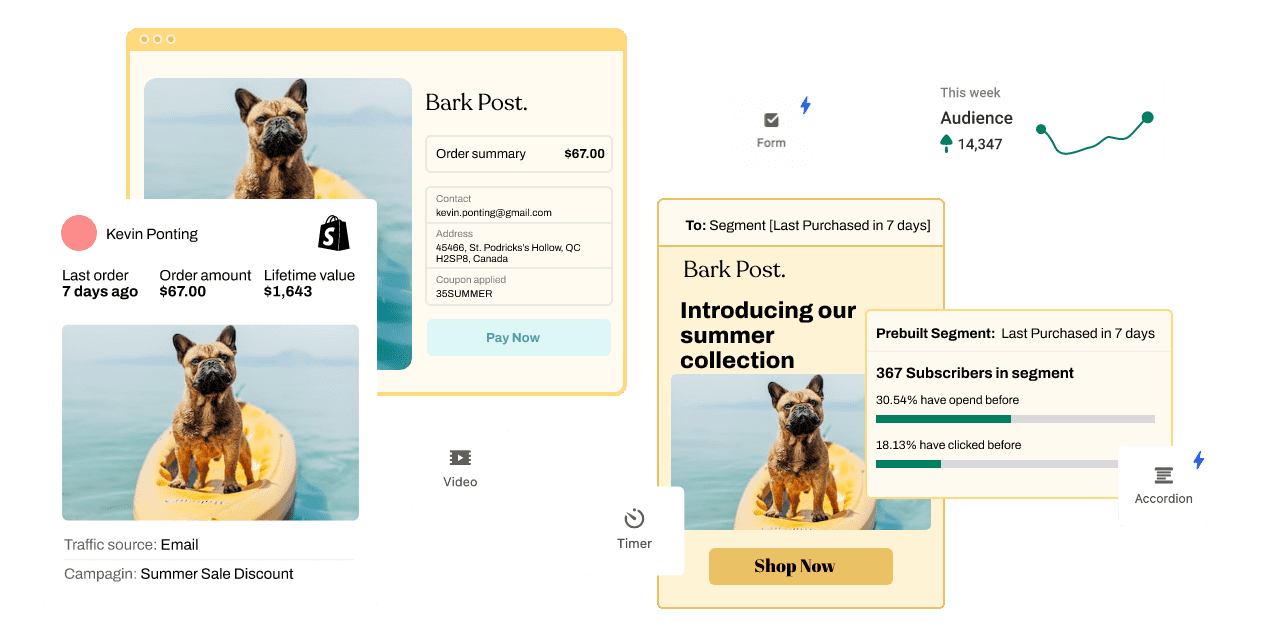
One of TinyEmail’s notable features is its abandon cart recovery workflow. This automates sending cart reminder emails to subscribers who started but did not complete purchases.
The reminders encourage subscribers to return and complete their checkout. You can customize the timing and content of abandoned cart emails for optimal results.
While GetResponse has robust automation, it lacks a streamlined and dedicated abandon cart recovery feature. TinyEmail provides an easy way to set up these automated workflows specifically for e-commerce.
TinyEmail also has an AI subject line assistant to help you craft a successful email marketing campaign with emails that will actually get opened.
Winner: GetResponse
Both GetResponse and TinyEmail has some features unique to each respective platform. However, GetResponse takes the prize for having the most unique features, such as the webinar marketing feature. TinyEmail offers a useful cart abandonment tool, but GetResponse enables entirely new lead generation and engagement tactics through its webinar integrations.
The ability to host webinars right inside your email marketing platform is game-changing. GetResponse essentially combines two powerful marketing channels – email and webinars – multiplying your strategy options. While both platforms have strengths, GetResponse provides uniqueness through its webinar features.
3. Ease of Use
GetResponse
GetResponse provides a user-friendly interface with intuitive navigation and workflows. The polished dashboard neatly organizes key tasks like campaign creation, list management, and reporting.
Common actions are accessible with just a click or two. GetResponse strikes a nice balance between simplicity for beginners and advanced functionality for experts. New users can easily set up basic email campaigns with the platform’s guided workflow.
Powerful features like automation and segmentation are made accessible through the well-designed interface. The learning curve is reasonable for most marketers to ramp up fully on GetResponse’s capabilities.
Overall, GetResponse delivers a professional, versatile platform that both email beginners and experienced marketers can use effectively. The thoughtful UX enhances usability across the board.
TinyEmail
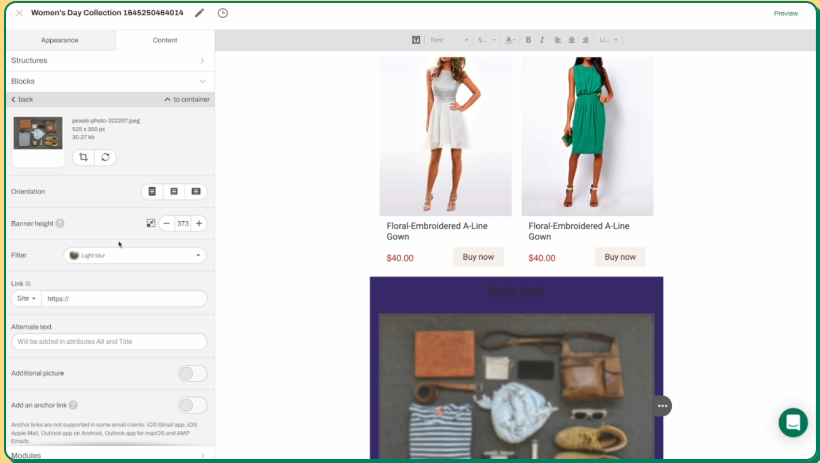
TinyEmail offers an easy-to-use interface focused on core email marketing needs. The stripped-down platform makes it fast for beginners to get started and send their first campaign.
However, more advanced users may find the platform overly simplistic. TinyEmail lacks many of the robust features offered by GetResponse. Their simplified UX is better suited for sending basic newsletters than complex behavioral automation.
Because of its pared-down interface, TinyEmail’s learning curve is quite small. But marketers may outgrow its limited capabilities quickly. While clean and intuitive, it ultimately lacks the sophistication of GetResponse’s UX.
Winner: GetResponse
GetResponse wins for superior usability and UX design. Its interface balances power with approachability better than TinyEmail. Beginners can easily get up and running thanks to logical workflows.
At the same time, experts will appreciate GetResponse’s expansive functionality. TinyEmail is simpler to start but tops out more quickly. For both new and experienced email marketers, GetResponse provides a better overall user experience.
4. Email Deliverability
GetResponse
GetResponse uses advanced deliverability features and practices to achieve industry-leading inbox placement rates. They maintain dedicated IP addresses with solid reputations to avoid blocking.
Email authentication protocols like SPF, DKIM, and DMARC improve deliverability by verifying sender identity. GetResponse also optimizes copy, content, and technical factors in their templates for each major email provider.
In addition, features like list cleaning and bounce handling help keep your sender score high. GetResponse users can expect consistently high inbox rates and low spam folder deliveries.
TinyEmail
As a newer platform, TinyEmail is still establishing deliverability rates and reputation. They advise customers to take steps like proper list building and authentication protocols.
However, TinyEmail lacks some of the more advanced inbox placement capabilities offered by veteran providers like GetResponse. Their less proven history and smaller scale may limit deliverability initially.
Over time, TinyEmail can strengthen its email reputation through sound sending practices. But in the short term, customers may see lower inbox rates compared to leading platforms. Their less established footing in email deliverability is a disadvantage.
Winner: GetResponse
With over 20 years of optimizing email delivery, GetResponse earns the win for superior inbox placement and sender reputation. Their history of reliable deliverability gives them an edge over newer competitors like TinyEmail who are still building trust and authority.
For marketers who depend on emails consistently reaching their inboxes, GetResponse provides greater assurance. Their deliverability track record and features make them the safer choice if a strong sender reputation is crucial.
5. Customer Support and Community
GetResponse
GetResponse provides 24/7 customer support via live chat, email, and phone. Users can also access an extensive self-serve knowledge base with FAQs, tutorials, and webinars.
The GetResponse user community is another valuable help resource. The active GetResponse Facebook group has over 25,000 members who share tips and advice.
Between prompt support channels and an engaged user community, GetResponse customers have several options to get questions answered quickly.
TinyEmail
TinyEmail offers email-based customer support during business hours. Phone and live chat support are not available currently.
Their online knowledge base provides some self-help resources including setup articles and campaign tips. However, the content is relatively thin compared to GetResponse.
The TinyEmail Facebook community page also has a smaller following but users can get their questions answered there.
While TinyEmail provides baseline support, GetResponse offers more robust options for getting issues resolved efficiently.
Winner: GetResponse
GetResponse wins for superior customer support based on its multiple channels available 24/7. Additionally, its long-established user community facilitates peer knowledge sharing.
TinyEmail trails behind with limited hours and channels, though they may expand support over time. For immediate, round-the-clock assistance, GetResponse has a clear advantage – critical for busy marketers who need timely solutions.
6. Integrations
GetResponse
GetResponse integrates with over 1,000 third-party apps and services via APIs and Zapier. Key integrations include leading CRMs, e-commerce platforms, webinar tools, and marketing & sales apps.
For example, integrate GetResponse with Shopify for abandoned cart automation and subscriber syncing. Connect it to Zoom to capture webinar registrants. Or link it to Google Analytics for expanded campaign insights.
Robust integrations allow you to connect GetResponse workflows with other critical business platforms for smoother data sharing and enhanced capabilities.
TinyEmail
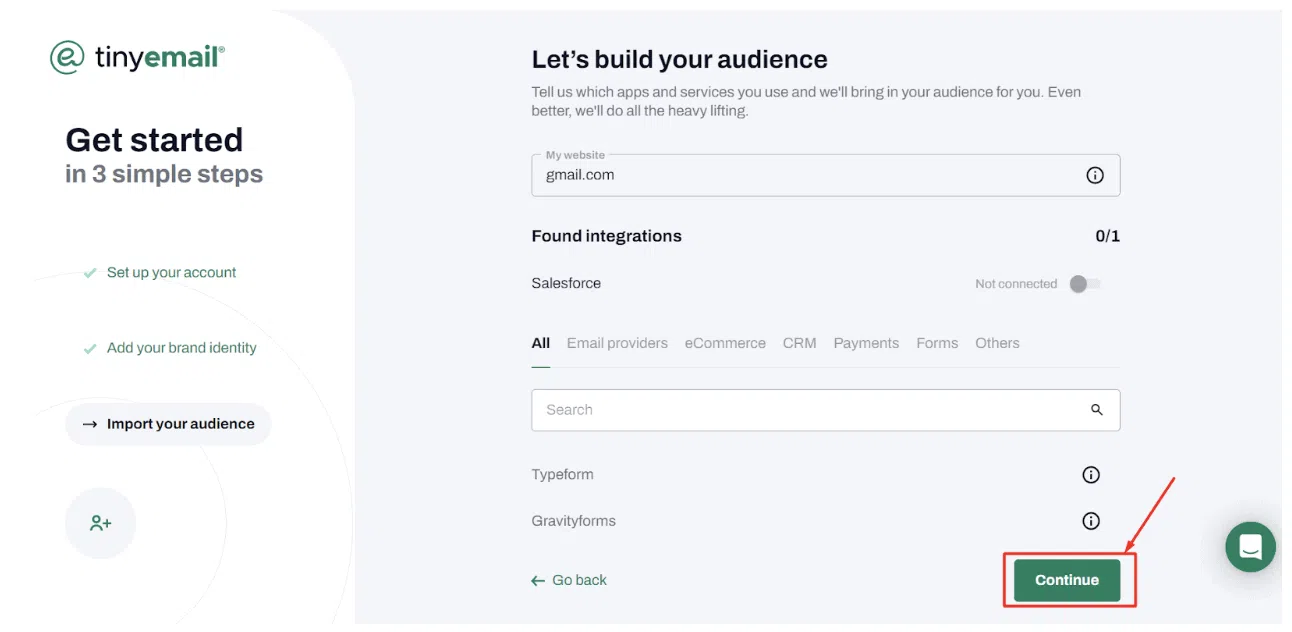
TinyEmail has integrations with many popular services like Mailchimp, Stripe, Zapier, and Salesforce. However, their integration offerings are not as vast as a mature platform like GetResponse.
With TinyEmail you can connect key systems like your CRM and ecommerce store. However, niche tool integrations may not be supported since TinyEmail’s catalog is still expanding.
While TinyEmail covers the basics, GetResponse simply offers far greater integration possibilities. Their extensive API and app partnerships enable complex workflows across more third-party systems.
Winner: GetResponse
GetResponse earns the win for its vast integration ecosystem that dwarfs TinyEmail’s offerings. The extensive catalog provides seamless interoperability between GetResponse and other essential business platforms. TinyEmail only scratches the surface of what GetResponse can accomplish through integrations.
For marketers who rely on connecting a multitude of apps and services, GetResponse delivers superior integration flexibility. TinyEmail may satisfy basic needs but lacks maturity in this area.
7. Pricing
GetResponse
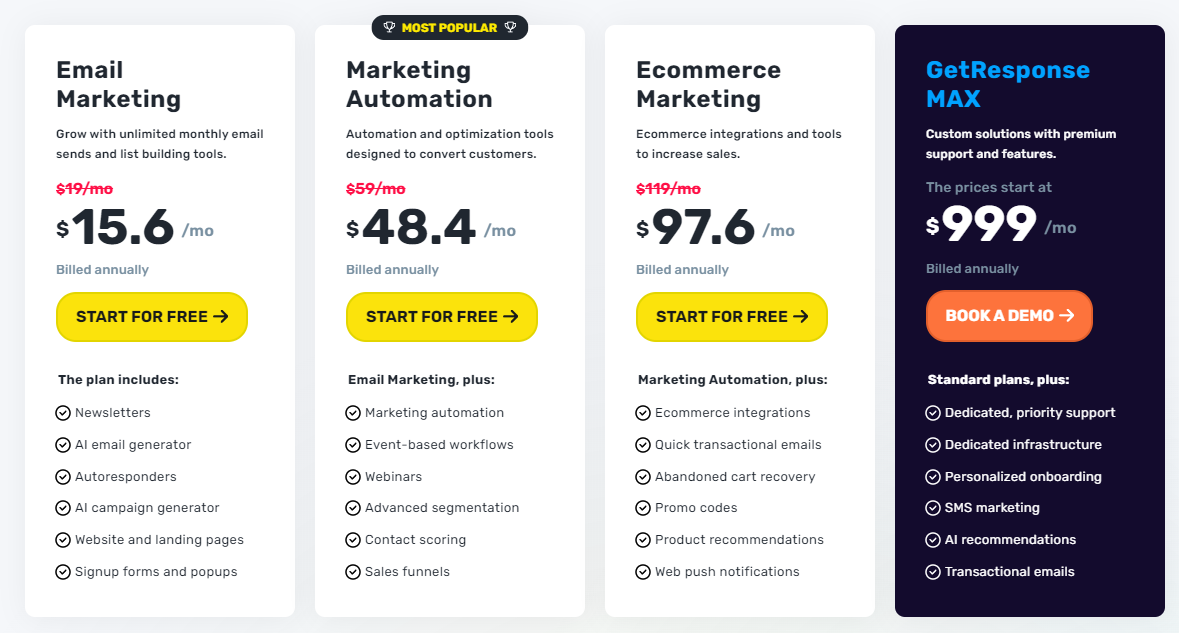
GetResponse offers 4 paid plans based on the number of contacts, from 1,000 up to unlimited. Their rates range from $15.60 – $999/month when billed annually.
The Starter plan includes basic features like surveys, popups, and basic reporting. The Max plan unlocks all advanced features and automation. Volume discounts are available.
GetResponse pricing corresponds to robust capabilities suited for larger lists and sophisticated campaigns. It provides strong value for established businesses with more complex needs. But may prove cost-prohibitive for smaller brands.
TinyEmail
TinyEmail has four premium plans:
- Free Plan – $0/mo for 500 contacts
- Standard – $15/mo for unlimited subscribers
- Pro – $65/mo for additional features and advanced functionality
- Enterprise – Custom pricing for all the platform’s core features and unlimited resources
The lower pricing of the basic plan matches TinyEmail’s positioning as an entry-level email platform focused on core features. Budget-conscious users will find TinyEmail’s rates more accessible than GetResponse.
Higher tiers provide more contacts, sequences, and premium integrations. All plans include core features, though some advanced options like A/B testing require Business or Pro.
Compared to GetResponse, TinyEmail offers lower entry pricing though less robust features on its starter plan. Its higher tier pricing is competitive for the segments targeted. However, advanced capabilities found in GetResponse will cost extra. TinyEmail pricing is straightforward but you get what you pay for in terms of feature breadth and scalability.
Winner: Tie
When it comes to pricing, neither platform clearly dominates. GetResponse provides premium capabilities for higher prices. TinyEmail offers basic features affordable for early-stage brands.
The “winner” depends on your budget and needs. For advanced automation and large contact volumes, GetResponse merits its higher costs. If you want just the essentials cheaply, TinyEmail has appeal. Overall the platforms cater to different audiences and offer different tools to aid your email marketing efforts, resulting in a tie.
8. Reviews and Reputation
GetResponse

GetResponse earns positive reviews for its powerful feature set and ease of use. Users praise the intuitive interface, extensive templates, and excellent deliverability.
However, some find the advanced features overwhelming. The complexity comes with a steeper learning curve despite the polished UX. Pricing is another common complaint for budget-limited users.
Overall, GetResponse garners an average rating of around 4 out of 5 stars on sites like G2, Capterra, and GetApp.
TinyEmail
Users on Trustpilot applaud TinyEmail for its simplicity of use and affordable pricing. The platform makes email marketing approachable for non-experts and early-stage businesses.
However, more advanced users lament the lack of complex features offered by competitors like GetResponse. Some reviews cite limitations with list segmentation, analytics, and automation.
Winner: GetResponse
GetResponse wins for better overall user sentiment, backed by higher average review scores. TinyEmail satisfaction is mixed, with some praising ease of use but others wanting more functionality.
GetResponse strikes a better balance between power and approachability that appeals to a wider range of users. While TinyEmail works for email beginners, GetResponse provides more versatility through reviews.
9. FAQ’s
GetResponse FAQs
- What types of email campaigns can I create?
GetResponse allows you to create newsletters, welcome campaigns, follow-up sequences, promotional emails, automated campaigns, and more. Any type of email campaign you need for your business is possible. - How many contacts can I have on my email list?
GetResponse offers paid plans that support up to 1,000 to unlimited contacts. Choose the plan that fits the size of your mailing list. - Can I integrate GetResponse with my e-commerce store?
Yes, GetResponse seamlessly integrates with all major e-commerce platforms like Shopify and WooCommerce using their integrations and APIs. - Does GetResponse allow SMS marketing?
GetResponse focuses solely on email marketing. For SMS capabilities, you will need an additional SMS platform integrated with GetResponse.
TinyEmail FAQs
- What email features does TinyEmail offer?
TinyEmail covers email marketing basics like list management, drag-and-drop builder, templates, and basic reports. Advanced features like super-detailed analytics or complex automation are not included. - How much does TinyEmail cost?
TinyEmail starts at just $15/month for unlimited contacts making it very budget-friendly for small businesses. Rates go up based on additional features like segments, an AI subject line generator, dedicated IP, and custom domains. - Can I send SMS campaigns with TinyEmail?
No, TinyEmail strictly provides email marketing tools. You would need to use a separate SMS platform and sync your contacts. - Is TinyEmail easy to use for beginners?
Yes, TinyEmail is designed for simplicity and ease of use making it great for non-technical beginners to start email marketing.
Final Thoughts
Choose GetResponse if…
GetResponse is the best choice for medium to large businesses that need advanced automation, detailed analytics, and robust integration capabilities.
The expansive feature set and enterprise-level email marketing tools make GetResponse well-suited for established brands with complex workflows or large lists. You’ll have all the power and customization you need as you scale.
Choose TinyEmail if…
TinyEmail is ideal for solopreneurs, startups, and small teams who want affordable pricing coupled with core email marketing features.
The simple interface and basic toolset provide just what early-stage businesses need to start building their email lists and campaigns. You’ll get up and running quickly without advanced extras you may not need yet.
If you aren’t sure if TinyEmail is right for you, consider reading my favorite TinyEmail Alternatives.
The Right Solution for You
Choosing the right email marketing tool ultimately depends on your specific business needs and budget. Do you need basic email marketing features or more advanced automation options? Make sure to select a solution tailored to your goals, contacts, and capabilities. And don’t hesitate to ask us any other questions in the comments to help guide you in the right direction!
